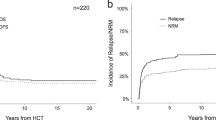Abstract
Patients with primary resistant and relapsed acute myeloid leukemia (AML) are rarely cured without undergoing allogeneic stem cell transplantation. What is currently debated is whether a trial of re-induction chemotherapy prior to transplantation is beneficial. Data from multiple retrospective analyses have shown that pretreatment variables are useful in predicting response to salvage chemotherapy. For patients unlikely to respond, re-induction attempts may be detrimental, leading to added organ toxicity and possible increased tumor resistance. Allogeneic transplantation in the setting of active disease is the alternative strategy. Multiple studies have demonstrated the feasibility of this approach, but cure rates have been low with the use of traditional transplant approaches. Newer strategies employing allogeneic transplantation earlier in patients with relapsed or refractory AML, as well as the incorporation of novel and effective antileukemic agents into the transplant conditioning regimen, may lead to better outcomes.
Similar content being viewed by others
References
Papers of particular interest, published recently, have been highlighted as: •• Of major importance
Burnett A, Wetzler M, Löwenberg B. Therapeutic advances in acute myeloid leukemia. J Clin Oncol. 2011;29(5):487–94.
Sierra J, Storer B, Hansen JA, Bjerke JW, et al. Transplantation of marrow cells from unrelated donors for treatment of high-risk acute leukemia: the effect of leukemic burden, donor HLA- matching, and marrow cell dose. Blood. 1997;90(11):4226–35.
Estey E, Thall P, David C. Design and analysis of trials of salvage therapy in acute myelogenous leukemia. Cancer Chemother Pharmacol. 1997;40(Suppl):S9–12.
Breems DA, Van Putten WL, Huijgens PC, et al. Prognostic index for adult patients with acute myeloid leukemia in first relapse. J Clin Oncol. 2005;23(9):1969–78.
•• Chevallier P, Labopin M, Turlure P, et al. A new Leukemia Prognostic Scoring System for refractory/relapsed adult acute myelogeneous leukaemia patients: a GOELAMS study. Leukemia 2011;25(6):939–44. This is a recent review of variables predicting response to salvage therapy in AML.
Ravandi F, Cortes J, Faderl S, et al. Characteristics and outcome of patients with acute myeloid leukemia refractory to 1 cycle of high-dose cytarabine-based induction chemotherapy. Blood. 2010;116(26):5818–23.
Giles F, O’Brien S, Cortes J, et al. Outcome of patients with acute myelogenous leukemia after second salvage therapy. Cancer. 2005;104(3):547–54.
Biggs JC, Horowitz MM, Gale RP, et al. Bone marrow transplants may cure patients with acute leukemia never achieving remission with chemotherapy. Blood. 1992;80(4):1090–3.
Brown RA, Wolff SN, Fay JW, et al. High-dose etoposide, cyclophosphamide and total body irradiation with allogeneic bone marrow transplantation for resistant acute myeloid leukemia: a study by the North American Marrow Transplant Group. Leuk Lymphoma. 1996;22(3–4):271–7.
Oyekunle AA, Kröger N, Zabelina T, et al. Allogeneic stem-cell transplantation in patients with refractory acute leukemia: a long-term follow-up. Bone Marrow Transplant. 2006;37(1):45–50.
Michallet M, Thomas X, Vernant JP, et al. Long-term outcome after allogeneic hematopoietic stem cell transplantation for advanced stage acute myeloblastic leukemia: a retrospective study of 379 patients reported to the Société Française de Greffe de Moelle (SFGM). Bone Marrow Transplant. 2000;26(11):1157–63.
•• Duval M, Klein JP, He W, et al. Hematopoietic stem-cell transplantation for acute leukemia in relapse or primary induction failure. J Clin Oncol. 2010;29(23):3730–8. This is the largest series of allogeneic transplants for refractory AML.
Schmid C, Schleuning M, Schwerdtfeger R, et al. Long-term survival in refractory acute myeloid leukemia after sequential treatment with chemotherapy and reduced-intensity conditioning for allogeneic stem cell transplantation. Blood. 2006;108(3):1092–9.
Feldman EJ, Lancet JE, Kolitz JE, et al. First-in-man study of CPX-351: a liposomal carrier containing cytarabine and daunorubicin in a fixed 5:1 molar ratio for the treatment of relapsed and refractory acute myeloid leukemia. J Clin Oncol. 2011;29(8):979–85.
Gergis U, Ritchie E, Roboz GJ, et al. A novel sequential treatment utilizing CPX-351 as salvage chemotherapy followed by a reduced intensity conditioning allogeneic stem-cell transplantation for patients with refractory leukemia. Biol Blood Marrow Transplant. 2011;17(2):S305–6. Supplement.
Scatena CD, Kumer JL, Arbitrario JP, et al. Voreloxin, a first-in-class anticancer quinolone derivative, acts synergistically with cytarabine in vitro and induces bone marrow aplasia in vivo. Cancer Chemother Pharmacol. 2010;66(5):881–8.
Disclosure
No potential conflicts of interest relevant to this article were reported.
Author information
Authors and Affiliations
Corresponding author
Rights and permissions
About this article
Cite this article
Feldman, E.J., Gergis, U. Management of Refractory Acute Myeloid Leukemia: Re-induction Therapy or Straight to Transplantation?. Curr Hematol Malig Rep 7, 74–77 (2012). https://doi.org/10.1007/s11899-011-0101-2
Published:
Issue Date:
DOI: https://doi.org/10.1007/s11899-011-0101-2




